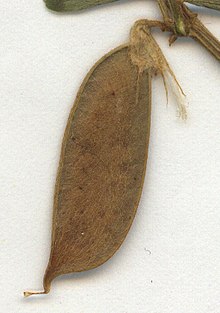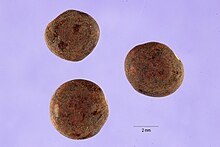Hungarian vetch
| Hungarian vetch | ||||||||||||
|---|---|---|---|---|---|---|---|---|---|---|---|---|

Hungarian Vetch ( Vicia pannonica subsp. Pannonica ) |
||||||||||||
| Systematics | ||||||||||||
|
||||||||||||
| Scientific name | ||||||||||||
| Vicia pannonica | ||||||||||||
| Crantz |
The Hungarian vetch , Pannonian vetch or Pannonian vetch ( Vicia pannonica ) is a species of plant from the genus vetch ( Vicia ) in the subfamily of the butterflies (Faboideae). It is spread from Algeria across Europe to the Caucasus and Western Asia. In the German-speaking area, it is indigenous only in the Pannonian region of Austria and occurs mostly only inconsistently in western Central Europe.
description
Appearance and leaf
The Hungarian vetch is an annual herbaceous plant . The prostrate, ascending or climbing stem , branched at most at the base and 20 to 50 centimeters long, is grooved and, like the leaves, usually soft to shaggy hairs.
The short stalked to almost sessile leaves are pinnate with seven to nine pairs of leaflets and tendrils. The rather weak tendrils are simple or branchy. The very short-stalked leaflets are linear to narrow, obovate, 1 to 1.5 centimeters long and 2 to 5 mm wide, blunt or truncated to shallowly edged and briefly acuminate and more or less closely hairy. The stipules are small, ovate-lanceolate to semi-spear-shaped, pointed and provided with narrow, brown nectaries .
blossom
The flowering period extends from April to June. The short stalked, nodding butterfly flowers are located individually or up to four in the leaf axils. The hermaphrodite flowers are 1.5 to 1.8 centimeters long, zygomorphic and five-fold with a double flower envelope . The five sepals are fused into a tubular to bell-shaped calyx, which is very crooked, greenish-white, densely hairy and ends with subtle to thready calyx teeth. The lower calyx teeth are about as long as the calyx tube and significantly longer than the upper ones. The crown has the typical shape of the butterfly flower and is more or less three times as long as the calyx tube, yellowish to purple-brown. The flag is stretched out straight, hairy on the outside, tightly pressed, with a mostly brown-red central stripe and a little longer than the wings and the shuttle .
Fruit and seeds
The legume is 2.5 to 3 centimeters long and 7 to 9 mm wide, strongly narrowed at both ends, light brown, shaggy to silky shimmering hairy and contains two to eight seeds. The seeds are spherical or more flattened and velvety rough.
Chromosome number
The number of chromosomes is 2n = 12.
Occurrence
The distribution area of the Hungarian vetch extends from Algeria and Spain in the west to the Caucasus and northwestern Iran in the east. In the north, indigenous populations extend to central France , the former Czechoslovakia and northern Ukraine . It is a naturalized neophyte in Germany, Switzerland and the Netherlands .
In Austria, the Hungarian vetch occurs scattered or rarely in the Pannonian region , otherwise only inconsistently in the colline to submontane altitude range . The indigenous occurrences are limited to the federal states of Vienna , Burgenland , Lower Austria and Upper Austria . In Germany it occurs scattered to seldom and mostly inconsistent, especially in the middle and southwest, z. B. in the Palatinate and in the Rhine - Main - Neckar area, in Bavaria especially in the area of the river valleys of the Main and Danube. The stocks in Central Europe are in decline.
The Hungarian vetch thrives best on sandy , loose loam soils , which are often poor in lime. It grows in Central Europe in cereal, clover and alfalfa fields, on fields, roadsides, more rarely fallow land and embankments and similar dry and warm biotopes . It applies in phytosociological system as characteristic species of Secalinetea.
Systematics
The first publication of Vicia pannonica took place in 1769 by Heinrich Johann Nepomuk von Crantz .
Vicia pannonica Crantz occurs in two subspecies, which differ in the color of the flowers:
- Common Hungarian vetch or Pannonian vetch in the narrower sense ( Vicia pannonica Crantz subsp. Pannonica ) has light yellow to almost white flowers. The number of chromosomes is 2n = 12 (rarely 14).
- Striped Hungarian vetch or striped vetch ( Vicia pannonica subsp. Striata (M.Bieb.) Nyman , Syn . : Vicia striata M.Bieb. , Vicia pannonica var. Purpurascens (DC.) Ser. ) Has dirty purple flowers. The number of chromosomes is 2n = 10.
use
The Hungarian vetch is used in Austria for greening embankments and was at least previously grown as a forage plant.
swell
literature
- Gustav Hegi, H. Gams, H. Marzell: Illustrated flora of Central Europe. Pteridophyta, Spermatophyta . 2nd Edition. Volume IV. Part 3: Angiospermae: Dicotyledones 2 (5) (Leguminosae - Tropaeolaceae) . Carl Hanser and Paul Parey, Munich and Berlin / Hamburg 1964, ISBN 3-489-70020-1 , p. 1552–1553 (unchanged reprint from 1923–1924 with addendum).
- Konrad von Weihe (ed.): Illustrated flora. Germany and neighboring areas. Vascular cryptogams and flowering plants . Founded by August Garcke. 23rd edition. Paul Parey, Berlin / Hamburg 1972, ISBN 3-489-68034-0 , p. 880 .
- Oskar Sebald, Siegmund Seybold, Georg Philippi (Hrsg.): The fern and flowering plants of Baden-Württemberg . tape 3 : Special part (Spermatophyta, subclass Rosidae): Droseraceae to Fabaceae . Eugen Ulmer, Stuttgart (Hohenheim) 1992, ISBN 3-8001-3314-8 , pp. 353-355 .
- Wolfgang Adler, Karl Oswald, Raimund Fischer: Excursion flora of Austria . Ed .: Manfred A. Fischer. Eugen Ulmer, Stuttgart / Vienna 1994, ISBN 3-8001-3461-6 , p. 477 .
- Christian Heitz: School and excursion flora for Switzerland. Taking into account the border areas. Identification book for wild growing vascular plants . Founded by August Binz. 18th completely revised and expanded edition. Schwabe & Co., Basel 1986, ISBN 3-7965-0832-4 .
- Erich Oberdorfer : Plant-sociological excursion flora . With the collaboration of Theo Müller. 6th, revised and expanded edition. Eugen Ulmer, Stuttgart (Hohenheim) 1990, ISBN 3-8001-3454-3 .
Individual evidence
- ^ Erich Oberdorfer : Plant-sociological excursion flora for Germany and neighboring areas . 8th edition. Verlag Eugen Ulmer, Stuttgart 2001, ISBN 3-8001-3131-5 . Page 614.
- ↑ a b Gustav Hegi, H. Gams, H. Marzell: Illustrierte Flora von Mitteleuropa. Pteridophyta, Spermatophyta . 2nd Edition. Volume IV. Part 3: Angiospermae: Dicotyledones 2 (5) (Leguminosae - Tropaeolaceae) . Carl Hanser and Paul Parey, Munich and Berlin / Hamburg 1964, ISBN 3-489-70020-1 , p. 1552–1553 (unchanged reprint from 1923–1924 with addendum).
- ^ A b c Vicia pannonica in the Germplasm Resources Information Network (GRIN), USDA , ARS , National Genetic Resources Program. National Germplasm Resources Laboratory, Beltsville, Maryland. Retrieved March 29, 2015.
- ^ A b c TG Tutin, VH Heywood, NA Burges, DM Moore, DH Valentine, SM Walters, DA Webb (eds.): Flora Europaea . Volume 2: Rosaceae to Umbelliferae . Cambridge University Press, Cambridge 1968, ISBN 0-521-06662-X , pp. 134 (English).
- ↑ a b c Hungarian vetch. In: FloraWeb.de.
- ↑ Vicia pannonica. In: Info Flora (the national data and information center for Swiss flora).
- ^ A b Manfred A. Fischer, Karl Oswald, Wolfgang Adler: Excursion flora for Austria, Liechtenstein and South Tyrol . 3rd, improved edition. Province of Upper Austria, Biology Center of the Upper Austrian State Museums, Linz 2008, ISBN 978-3-85474-187-9 , p. 738 .
- ↑ a b Dietmar Aichele, Heinz-Werner Schwegler: The flowering plants of Central Europe . 2nd Edition. tape 2 : Yew family to butterfly family . Franckh-Kosmos, Stuttgart 2000, ISBN 3-440-08048-X , p. 500 .
- ^ Oskar Sebald, Siegmund Seybold, Georg Philippi (ed.): The fern and flowering plants of Baden-Württemberg . tape 3 : Special part (Spermatophyta, subclass Rosidae): Droseraceae to Fabaceae . Eugen Ulmer, Stuttgart (Hohenheim) 1992, ISBN 3-8001-3314-8 , pp. 353-355 .
- ^ Heinrich Johann Nepomuk von Crantz: Stirpium Austriacarum Pars II. Editio altera aucta. Johann Paul Kraus, Vienna 1769, p. 339 ( online ).
- ↑ a b Ordinary Hungarian vetch. In: FloraWeb.de.
- ↑ Vicia pannonica , chromosome number at Tropicos.org. Missouri Botanical Garden, St. Louis, accessed March 28, 2015.
- ^ Striped Hungarian vetch. In: FloraWeb.de.
- ↑ Vicia pannonica subsp. purpurascens , chromosome number at Tropicos.org. Missouri Botanical Garden, St. Louis, accessed March 28, 2015.
Web links
- Hungarian vetch. In: FloraWeb.de.
- Hungarian vetch . In: BiolFlor, the database of biological-ecological characteristics of the flora of Germany.
- Distribution map for Germany. In: Floraweb .
- Distribution map for Germany. In: Floraweb . Vicia pannonica subsp. striata
- Vicia pannonica Crantz In: Info Flora , the national data and information center for Swiss flora . Retrieved November 24, 2015.
- Thomas Meyer: Data sheet with identification key and photos at Flora-de: Flora von Deutschland (old name of the website: Flowers in Swabia )





